Interviews with Past Winners
Naoki Ogishita / Koichiro Oishi
sukeru hasami(Transparent Scissors)
2014 Grand Prix
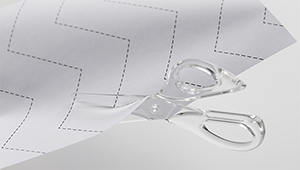
"NEXT QUALITY" does not mean just making a proposal for something that is possible now
The creators of the amazing Kokuyo Design Award 2014 Grand-Prix winning artwork “sukeru hasami (Transparent Scissors)”, Naoki Ogishita and Koichiro Oishi, talked to us about their actual experience, from their stories about taking part in the competition to their situation after receiving the award.
―― Please tell us about the reasons why you decided to enter the Kokuyo Design Award competition.
Ogishita: Oishi-kun and I went to the same university and now we are both working in product design at different companies. It is several years now since we started working and around the time we had got somewhat used to work, we just started to talk naturally about how nice it would be if we could make something good together.
Oishi: We thought seriously about something that would be helpful to people and we decided to try and make it ourselves. Just at that time, Kokuyo Design Award 2014 had started to ask for entries and the theme of "NEXT QUALITY" perfectly matched our feeling of "seriously wanting to make something good".
―― Please tell us the story of how you got the idea for the winning award, "sukeru hasami (Transparent Scissors)"
Ogishita: Firstly, after thoroughly reading the text about the theme and the messages from the judges, we came to get an idea about what kind things we should think about and what kind of proposal for artwork was required.
Oishi: This time we took two approaches. One way was to start with the theme for entries to the competition. So we wrote down as many different kinds of stationery and furniture as we could think of and for each one we thought about something connected to "NEXT QUALITY". The other way was to write down lots of different ideas and intently exchange these ideas back and forth in order to generate new and unexpected ideas. One of us would put an idea forward and the other would lightly add some more words. Even outside the times when we were directly meeting and talking we were always coming up with ideas.
Ogishita: On one occasion, the word "transparent" came up and I began to add this word to nouns for stationery, such as "pen", "tape" and "cutter". When it came to "transparent", "scissors", we found that this image developed further within ourselves.
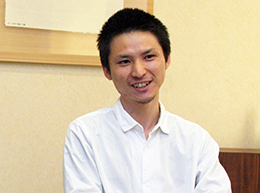
―― Which points did you focus on for the preliminary selection process?
Ogishita: Keeping the presentation message simple and raising the quality of the proposal thoroughly. We knew that in the preliminary screening the time that the judges have to look at the presentation sheet is very limited and the time allotted for the final review is 5 minutes. There were many things that we wanted to convey but we made an assessment of the points that were really necessary and those things that were superfluous and narrowed the content down to the points that we most wanted to communicate. As a result of practicing many times, the actual presentation was exactly 5 minutes. We added a sense of rhythm to the presentation and prepared a video so that those listening would not get bored.
Oishi: Also, connected to the fact that the theme was "NEXT QUALITY", we spent a lot of time right up until the last moment perfecting the quality of the content of the proposal. Since this was an award for design, of course we focused on its beauty as an object but we also wanted to make the object with its function as scissors working properly. In any case, we bought a lot of scissors and studied them.
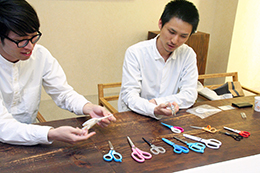
Ogishita: At the time of the preliminary screening we had assumed that the material for the scissors would be transparent acrylic. However, whist we were trying out a lot of scissors, we found that there was a limit to the cutting sharpness of the plastic scissors. So, we were desperately looking for a material that was transparent and could improve the sharpness. This is when we came across a relatively new material called "transparent ceramics".
Oishi: But as it is a material for which use of mass production has not yet been established, honestly we just did not know whether we could propose it or not at the final review. We thought we would be told, "Isn't this impossible realistically?" However, on the other hand, since the theme was "NEXT QUALITY", we thought that it was not a good idea to just propose something that is possible to make now, so we decided to take the plunge and propose "transparent ceramics" which has the possibility of future mass production.
―― As a result, you received a high evaluation for your proposal, including your proposal for a specific material. How did you feel at the moment when the Grand Prix was decided?
Oishi: I was happy. To be honest, I had felt confident. Because there was the sense of having "done everything to the end". In the Kokuyo Design Award the contest goes as far as a secondary selection (final review) and we rarely get such an opportunity to make presentations right up to the stage of producing a model. I felt that this competition gave us a sense of having taken the plunge and doing our best right up to the end.
―― Did you experience any kind of changes as a result of receiving the Kokuyo Design Award?
Ogishita: Both of us formed a unit called "oog" and have started our activities. In actual fact, in order to relieve our tension during the waiting time for the final review, we were trying to think about other things and came up with the unit name and logo! The "oog" is derived from the initials of our two names, but it also means "eye" in Dutch. This matched our way of thinking that we want to make nice things after careful observation, and at the social gathering after winning the award, we officially decided to continue our work together.
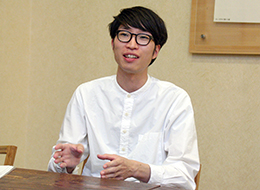
Oishi: The experience with Kokuyo Design Award gave me motivation and a certain resolution. To continue working as a unit I think that the chemistry is very important. When one keyword is said, it is like the same kind of image comes into both of our minds without exchanging a lot of words.... On top of that, I felt that the scope of our ideas widened, we could divide up the tasks and when one partner finds his ideas drying up or that he is about to compromise, the other partner spurs him on which also leads to a guarantee of quality.
―― Please tell us about your future activities.
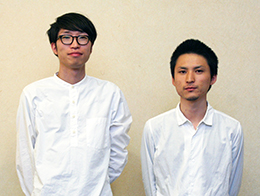
Ogishita: We want to continue by carefully giving shape to our ideas, one by one. We are committed to our activities as oog with the original pure ambition of "wanting to create good tools that are useful for people".
oog HP:
http://www.d-oog.com
![]()
























